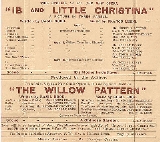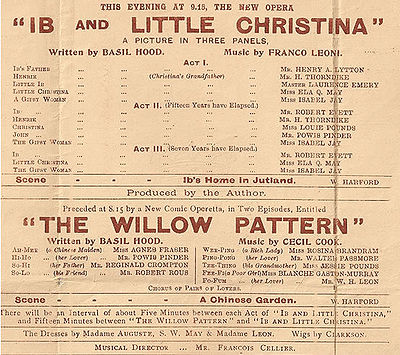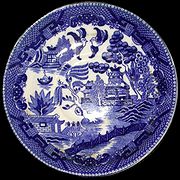
The Willow Pattern
Encyclopedia

Comic opera
Comic opera denotes a sung dramatic work of a light or comic nature, usually with a happy ending.Forms of comic opera first developed in late 17th-century Italy. By the 1730s, a new operatic genre, opera buffa, emerged as an alternative to opera seria...
with a libretto by Basil Hood
Basil Hood
Basil Willett Charles Hood was a British librettist and lyricist, perhaps best known for writing the libretti of half a dozen Savoy Operas and for his English adaptations of operettas, including The Merry Widow. He embarked on a career in the British army, writing theatrical pieces in his spare...
and music by Cecil Cook. It was first performed at the Savoy Theatre
Savoy Theatre
The Savoy Theatre is a West End theatre located in the Strand in the City of Westminster, London, England. The theatre opened on 10 October 1881 and was built by Richard D'Oyly Carte on the site of the old Savoy Palace as a showcase for the popular series of comic operas of Gilbert and Sullivan,...
on 14 November 1901, running for a total of 110 performances. It toured thereafter.
The Willow Pattern was a companion piece to Ib and Little Christina
Ib and Little Christina
Ib and Little Christina refers to two theatrical adaptations by Basil Hood of the 1855 fairy tale by Hans Andersen of the same name.The first was a play styled "A Picture in 3 Parts", with incidental music by Arthur Bruhns and was first produced at the Prince of Wales Theatre, opening on 15 May...
and later Iolanthe
Iolanthe
Iolanthe; or, The Peer and the Peri is a comic opera with music by Arthur Sullivan and libretto by W. S. Gilbert. It is one of the Savoy operas and is the seventh collaboration of the fourteen between Gilbert and Sullivan....
. It and was toured in Britain and America. A copy of the printed libretto is in the British Library, at 11778.f.23(5). (1901). The vocal score was published by Chappells, and a copy is in British Library at F.690.j.(2) [1902].
A silent film of the legend was made in 1914, called Story of the Willow Pattern.
When the Gilbert and Sullivan
Gilbert and Sullivan
Gilbert and Sullivan refers to the Victorian-era theatrical partnership of the librettist W. S. Gilbert and the composer Arthur Sullivan . The two men collaborated on fourteen comic operas between 1871 and 1896, of which H.M.S...
partnership disbanded after the production of The Gondoliers
The Gondoliers
The Gondoliers; or, The King of Barataria is a Savoy Opera, with music by Arthur Sullivan and libretto by W. S. Gilbert. It premiered at the Savoy Theatre on 7 December 1889 and ran for a very successful 554 performances , closing on 30 June 1891...
in 1889, impresario Richard D'Oyly Carte
Richard D'Oyly Carte
Richard D'Oyly Carte was an English talent agent, theatrical impresario, composer and hotelier during the latter half of the Victorian era...
and, after his death, his widow Helen Carte, filled the Savoy Theatre with a combination of new works and revivals of the Gilbert and Sullivan
Gilbert and Sullivan
Gilbert and Sullivan refers to the Victorian-era theatrical partnership of the librettist W. S. Gilbert and the composer Arthur Sullivan . The two men collaborated on fourteen comic operas between 1871 and 1896, of which H.M.S...
operas. The fashion in the late Victorian era
Victorian era
The Victorian era of British history was the period of Queen Victoria's reign from 20 June 1837 until her death on 22 January 1901. It was a long period of peace, prosperity, refined sensibilities and national self-confidence...
and Edwardian era was to present long evenings in the theatre, and so producer Richard D'Oyly Carte
Richard D'Oyly Carte
Richard D'Oyly Carte was an English talent agent, theatrical impresario, composer and hotelier during the latter half of the Victorian era...
preceded his Savoy opera
Savoy opera
The Savoy Operas denote a style of comic opera that developed in Victorian England in the late 19th century, with W. S. Gilbert and Arthur Sullivan as the original and most successful practitioners. The name is derived from the Savoy Theatre, which impresario Richard D'Oyly Carte built to house...
s with curtain raisers
Curtain raiser (drama)
A curtain raiser is a performance, stage act, show, actor or performer that opens a show for the main attraction. The term is derived from the act of raising the stage curtain...
, like The Willow Pattern. W. J. MacQueen-Pope
W. J. MacQueen-Pope
Walter James MacQueen-Pope was an English theatre historian and publicist. From a theatrical family which could be traced back to contemporaries of Shakespeare, he was in management for the first part of his career, but switched to publicity, in which field he became well-known...
commented, concerning such curtain raisers:
- This was a one-act play, seen only by the early comers. It would play to empty boxes, half-empty upper circle, to a gradually filling stalls and dress circle, but to an attentive, grateful and appreciative pit and gallery. Often these plays were little gems. They deserved much better treatment than they got, but those who saw them delighted in them. ... [They] served to give young actors and actresses a chance to win their spurs ... the stalls and the boxes lost much by missing the curtain-raiser, but to them dinner was more important.
Synopsis
The libretto follows the familiar legend of the willow patternWillow pattern
The Willow pattern, more commonly known as Blue Willow, is a distinctive and elaborate pattern used on ceramic kitchen/housewares. The pattern was designed by Thomas Minton around 1790 and has been in use for over 200 years. Other references give alternative origins, such as Thomas Turner of...
, but with the addition of some extra characters, notably a rogue, PingPong, who helps to trick the father into allowing his daughter to marry her lover.

Once there was a wealthy mandarin, who had a beautiful daughter. She had fallen in love with a humble accountant, angering her father. He dismissed the young man and built a high fence around his house to keep the lovers apart. The Mandarin was planning for his daughter to marry a powerful Duke. The Duke arrived by boat to claim his bride, bearing a box of jewels as a gift. The wedding was to take place on the day the blossom fell from the willow tree.
On the eve of the daughter's wedding to the Duke, the young accountant, disguised as a servant, slipped into the palace unnoticed. As the lovers escaped with the jewels, the alarm was raised. They ran over a bridge, chased by the Mandarin, whip in hand. They eventually escaped to the safety of a secluded island, where they lived happily for years. But one day, the Duke learned of their refuge. Hungry for revenge, he sent soldiers, who captured the lovers and put them to death. The Gods, moved by their plight, transformed the lovers into a pair of doves.
Roles and cast
- Ah Mee, a maiden. Agnes Fraser
- Hi Ho, her lover. Powis Pinder
- So Hi, her father. Reginald Crompton
- So Lo, his friend. Robert Rous
- Wee Ping, a rich lady. Rosina BrandramRosina BrandramRosina Brandram was an English opera singer and actress primarily known for creating many of the contralto roles in the Savoy operas with the D'Oyly Carte Opera Company....
- Ping Pong. Walter PassmoreWalter PassmoreWalter Henry Passmore was an English singer and actor best known as the first successor to George Grossmith in the comic baritone roles in Gilbert and Sullivan operas with the D'Oyly Carte Opera Company....
- Tee Thing, his grandmother. Jessie Pounds
- Fee Fi, a poor girl. Blanche Gaston Murray
- Fo Fum, her lover. W. H. Leon
Because Ib and Little Christina was shorter than Iolanthe, The Willow Pattern was condensed when it was revived with the latter opera. The cast was reduced to the following four characters: Ah Mee, HiHo, SoHi (Rudolph Lewis), and PingPong (Robert Rous).
External links
- http://math.boisestate.edu/gas/companions/index.htmlList of Savoy operaSavoy operaThe Savoy Operas denote a style of comic opera that developed in Victorian England in the late 19th century, with W. S. Gilbert and Arthur Sullivan as the original and most successful practitioners. The name is derived from the Savoy Theatre, which impresario Richard D'Oyly Carte built to house...
companion pieces] - Article on Savoy curtain raisers
- A review of The Willow Pattern and Iolanthe
- Site links to a transcript of the Legend of the willow pattern
- Another site with information about the legend of the willow pattern

